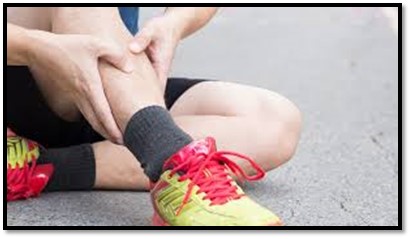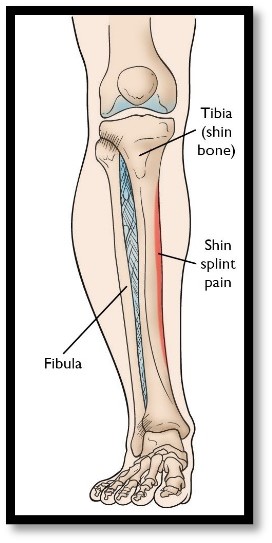02/22/2022
Prevention and Treatment of Shin Splints
By Jon Mousette, ATC, Spaulding High School Athletic Trainer
Are you one of many individuals whose shins ache when you exercise? Then you may suffer from shin splint. If you are an athlete or active individual, you likely know someone who has dealt with the pain from this injury or have experienced it yourself. Continue reading below to find more information on what exactly shin splints are, the causes, and how you can treat them or possibly prevent them from happening in the future.


The proper medical term for this condition is medial tibial stress syndrome and it is an inflammation of the muscles, tendons, and bone tissue around your tibia. Shin splints became a more common term, describing the targeted pain on the inside of your tibia, or “shin bone”. The pain generally starts as a strained soreness. If left untreated, the pain can intensify and leave you physically unable to continue with your sport or preferred activity. The symptoms of shin splints can be different for everyone, ranging from a dull ache to a sharp, stabbing pain. Most times, you will be able to pinpoint a tender portion on the inside of your lower shin.
Some risk factors for shin splints include:
- A sudden increase in the level of intensity of your workout or sport
- Over training
- Runners, both beginners and seasoned
- Running on hard, flat surfaces such as concrete or asphalt
- Having flat feet or high arches
- Being in military training
Prevention is a significant component to keeping your shins in proper working condition. Completing a good warmup before working out can help ease your muscles into physical activity. Overall, stretching and foam rolling will also help your muscles to stay healthy. If prevention was not enough, simple measures can help to ease the discomfort of shin splints before the pain spirals out of control. Proper footwear is also a large component to preventing injury. Replace your shoes as they wear down, similar to how you would replace the tires on your care. More miles means you may need to replace them sooner. Also, ensure you are wearing the correct footwear. Feet are not one size fits all, and it may be beneficial to be fitted by a professional to ensure the best fit and level of support that you require.
Adding weight training to your schedule will strengthen other areas of your body and allow you to protect yourself from injury. Remember, strength takes time. Focusing on your muscles and allowing your body to get stronger may help to prevent future injury.
Gradually increase your level of activity as your body allows. If you are used to running two miles at a time, your body is not ready to run a marathon the very next day. Overloading your body can take a toll on your shins. If your shins are starting to feel sore and tired, allow them to rest.
Switching up your activity temporarily allows you to get stronger but can decrease the load on your tired shins. Biking, swimming, and use of the elliptical can be great ways to cross train and allow your body to heal.
Treatments for shin splints can vary, and you are able to easily do many at home. RICE, as you may be familiar with, stands for Rest, Ice, Compression, and Elevation. While a great first step, there are other things that may also help with shin splints as well.
The use of ice, also known as cryotherapy, can be beneficial in the reduction of the pain associated with shin splints. When icing, be sure to use the 20/20 rule- this means to ice the area for 20 minutes, then remove the ice and wait for at least 20 minutes to begin icing again. By doing this, your leg is able to warm up, blood supply recirculates, and healing increases in effectiveness. Additionally, adding range of motion exercises in the periods between icing will allow your muscles to work better. Try to elevate your legs above the level of your heart. While your leg is elevated, use your toes to make circles in the air working your way from small to large circles. You may also “trace” the letters of the alphabet or spell your name in the air. While your leg is elevated, the gravity allows for any swelling in your leg to decrease, and move out of the area. A decrease in swelling can also help to decrease the pain.
The use of NSAID (nonsteroidal anti-inflammatory drug) medications such as Ibuprofen or Advil will also help to decrease the overall pain and swelling. Follow the directions on the back of the medication bottle, and take the medications every few hours as directed. This may help to improve your symptoms and allow you to eventually ease back into your activities. Be sure to check with your doctor to ensure you have no other conditions that would prevent you from taking these medications.
When is it time to get further help?
If you have tried treating your shin splints at home without any improvement, it may be a good time to reach out to your healthcare team. Your school athletic trainer is a tremendous resource to start with, helping to review your signs and symptoms and weighing treatment options. They may recommend you connect with your primary care or orthopedic provider or seek physical therapy. Orthotic inserts or a detailed analysis of your walking/running pattern are other considerations. Your treatment team will help you rule out more serious injury, like a stress fracture or other medical conditions. Ultimately, they’re all there to assist you and help get you back in the game!

Jon Mousette is a certified Athletic Trainer through the National Athletic Trainers Association. Jon graduated from Plymouth State University with a bachelor’s degree in Athletic Training. He has been the Head Athletic Trainer at Spaulding High School since 2013. During the summers he conducts team strength and conditioning sessions for his athletic programs.
Your opinion matters! We value your input and hope you’ll take a moment to review our newsletter and share your thoughts on future content. Please consider filling out this brief survey.